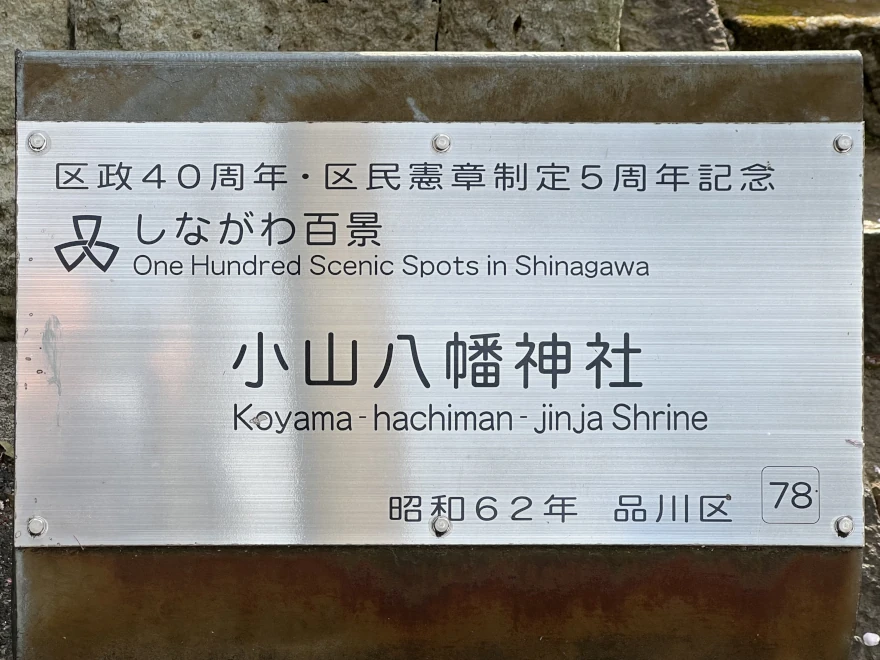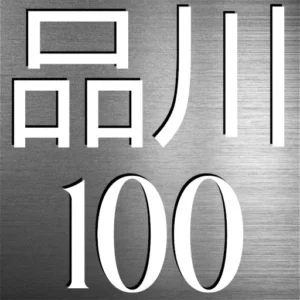Koyama Hachiman Shrine – A Shrine with Divided Origins
Koyama Hachiman Shrine (小山八幡神社) stands atop a high ridge in Nishi-Koyama, serving as one of the most prominent and historic Shinto shrines in the area. Revered since at least the Kamakura period, it was likely first established in the early 11th century (c. 1030), when the warrior Minamoto no Yoriyoshi is said to have enshrined the deity Hondawake no Mikoto, associated with Hachiman, on this elevated site to watch over the original village of Koyama.
The shrine sits 35 meters above sea level – the highest natural point in Shinagawa Ward – and offers excellent views across the city. In the Edo period, it was a small but important guardian of the community, until a religious schism in the 17th century led to the establishment of a breakaway shrine in nearby Mitani. Today, the two are reunited once a year during the Koyama Ryōsha-sai Mikoshi Togyo, a joint mikoshi procession that brings seven portable shrines from both neighbourhoods into a shared parade route between Musashi-Koyama and Nishi-Koyama.
In recent years, the shrine has undergone a major restoration project to address structural aging and improve accessibility. Completed in December 2024, the renovations included barrier-free pathways, building reinforcements, and future planning for reforestation of the precincts. By 2030, the shrine hopes to celebrate its 1000th anniversary as a renewed spiritual and cultural center for the community.
⛩️ Shrine Details
- Enshrined Deity: Hondawake no Mikoto (誉田別命), the deified Emperor Ōjin, worshipped as Hachiman
- Founded: Traditionally dated to 1030 CE (Chōgen 3) by Minamoto no Yoriyoshi
- Notable Feature: Believed to be built atop a kofun (ancient burial mound)
- Site Feature: Highest natural ground in Shinagawa (35m elevation)
- Affiliation: One of the Seven Lucky Gods of Ebara – enshrines Daikokuten (大國天)
- Annual Events: New Year rituals, Setsubun, Daikokuten Festival (May 15), Great Purification (June & December), and Ryōsha-sai Mikoshi Parade (early September)
- Recent Restoration: Completed in December 2024
Today, the shrine continues to serve as a place of spiritual connection, local identity, and seasonal celebration. With renewed facilities and deep historical roots, it looks to the future while honouring its past. It is also on the Ebara Seven Lucky Gods Tour.
🎉 Ebara Seven Lucky Gods Tour – A New Year’s Pilgrimage of Fortune
The Ebara Shichifukujin Meguri (荏原七福神めぐり) is a traditional New Year’s pilgrimage that connects seven sacred sites across the historic Ebara area of Shinagawa. Pilgrims walk a roughly 5-kilometer route, collecting red stamps at each stop and praying for good fortune, health, wealth, and longevity. It’s a joyful seasonal event that blends Edo-period religious customs with modern neighborhood charm.
The tour is active annually from January 1–7, with reception hours from 10:00 to 16:00. Pilgrims can purchase a special shikishi (decorative board) to collect all seven deity stamps. Those who complete the circuit are awarded a commemorative ema (絵馬) at the final stop. No strict order is required, and many participants make a day of it, visiting local restaurants or shops along the way.
🗺️ The Seven Deities and Their Temples
- 1. Daikokuten (大黒天) – Koyama Hachiman Shrine (小山八幡神社) – God of wealth, harvest, and household protection
- 2. Ebisu (恵比寿) – Hōren-ji Temple (法蓮寺) – God of prosperity in business and fishing
- 3. Bishamonten (毘沙門天) – Myōren-ji Temple (妙蓮寺) – Guardian of warriors and bringer of good fortune
- 4. Benzaiten (弁財天) – Yakuō-in Temple (薬王院) – Goddess of music, art, and learning
- 5. Fukurokuju (福禄寿) – Shinpuku-ji Temple (真福寺) – God of wisdom, longevity, and happiness
- 6. Jurōjin (寿老人) – Josho-ji Temple (常称寺) – God of long life and vitality
- 7. Hotei (布袋尊) – Yōgyokuin Nyorai-ji Temple (養玉院如来寺) – God of abundance, laughter, and contentment
Each stop features its own distinct history, and together they form a spiritual circuit of Shinagawa’s Ebara district. Some temples date back centuries and include architectural or cultural features of interest beyond the pilgrimage itself. The entire route can be walked in about two hours, depending on pace and photo stops.
Pro tip: Manga-style illustrations of each deity are also available at the temples, adding a modern and playful touch for families or collectors.
Official Website: ebara-shichifuku.com
🧭 Koyama Hachiman Shrine Visitor Information
Address: 5-6-3 Koyama, Shinagawa-ku, Tokyo 142-0062
Best season: Early September (for the Ryōsha-sai Mikoshi parade)
Admission: Free
Official Info: Koyama Hachiman Shrine
Note: Be respectful during festivals — mikoshi events are loud but spiritually significant.
Where is it?
| what3words | ///arch.caramel.parade |
| latitude longitude | 35.61199, 139.70001 |
| Nearest station(s) | Nishi-Koyama Station (Tokyu Meguro Line) Musashi-Koyama Station (Tokyu Meguro Line) |
| Nearest public conveniences | Nearby parks or convenience stores Koyama |
Show me a sign.

At the entrance – by the foot of the steps.
Withervee says…
When I first visited in 2024 it was closed; a building site. Apparently, some of the land has been sold to build apartments. In 2025 there are a few temple structures but as the temple web site says it may not be fully completed until 2030.
Nevertheless, it’s a tranquil, historic spot for reflection, ideal for a brief visit. While not glamorous, its peaceful charm and local character make it worthwhile — especially during the Ryōsha-sai mikoshi parade or when strolling between nearby sakura-lined avenues and historic paths.
I have been told that since it is near the top of an Edomizaka (Edo-viewing slope) Tokyo Bay around Omori could once be seen from here. Now surrounded by housing, there is no sweeping panoramic view, just hints of cityscape. Does this mean that the scenic spot is the temple, or is it the view from the temple, or both? I’m not going to lose sleep over it, go and have a look for yourself.
Site Character
- Lifestyle 生活 (Seikatsu): ✔️
- Historical Significance 歴史 (Rekishi): ✔️
- Atmosphere/Natural Features 風土 (Fūdo): ✔️
Who in their right mind would vote for this?
- Local Shinto believers
- Traditionalists
- History buffs
- Quiet souls
- Neighbourhood walkers
Further reading
Koyama Hachiman Shrine – Wikipedia (Japanese)
While you’re there…
Take a short walk over to the famous Nishi-Koyama cherry blossom street if visiting in spring. Or go over to Musashikoyama for shopping and refreshments or Rinshi no Mori for a walk in a park,

